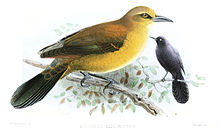
The red-winged blackbird is a passerine bird of the family Icteridae found in most of North America and much of Central America. It breeds from Alaska and Newfoundland south to Florida, the Gulf of Mexico, Mexico, and Guatemala, with isolated populations in western El Salvador, northwestern Honduras, and northwestern Costa Rica. It may winter as far north as Pennsylvania and British Columbia, but northern populations are generally migratory, moving south to Mexico and the Southern United States. Claims have been made that it is the most abundant living land bird in North America, as bird-counting censuses of wintering red-winged blackbirds sometimes show that loose flocks can number in excess of a million birds per flock and the full number of breeding pairs across North and Central America may exceed 250 million in peak years. It also ranks among the best-studied wild bird species in the world. The red-winged blackbird is sexually dimorphic; the male is all black with a red shoulder and yellow wing bar, while the female is a nondescript dark brown. Seeds and insects make up the bulk of the red-winged blackbird's diet.

The white-faced ibis is a wading bird in the ibis family, Threskiornithidae.

The sora is a small waterbird of the rail family Rallidae, sometimes also referred to as the sora rail or sora crake, that occurs throughout much of North America. The genus name Porzana is derived from Venetian terms for small rails, and the specific carolina refers to the Carolina Colony. The common name "Sora" is probably taken from a Native American language.

The eastern screech owl or eastern screech-owl, is a small owl that is relatively common in Eastern North America, from Mexico to Canada. This species resides in most types of woodland habitats across its range, and is relatively adaptable to urban and developed areas compared to other owls. Although it often lives in close proximity to humans, the eastern screech owl frequently avoids detection due to its strictly nocturnal habits.

The long-toed stint is a small wader. The genus name is from Ancient Greek kalidris or skalidris, a term used by Aristotle for some grey-coloured waterside birds. The specific subminuta is from Latin sub, "near to" and minuta, "small" from its similarity to the little stint, Calidris minuta.

The yellow-headed blackbird is a medium-sized blackbird with a yellow head.
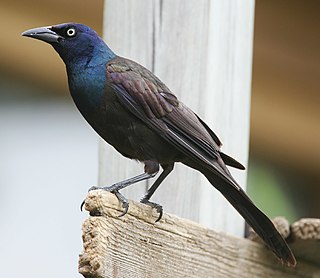
The common grackle is a species of large icterid bird found in large numbers through much of North America. First described in 1758 by Carl Linnaeus, the common grackle has three subspecies. Adult common grackles have a long and dark bill, pale yellow eyes, and a long tail. Adults often have an iridescent appearance on their head, especially males. Common grackles can be found widely across North America east of the Rocky Mountains.

The scarlet tanager is a medium-sized American songbird. Until recently, it was placed in the tanager family (Thraupidae), but it and other members of its genus are now classified as belonging to the cardinal family (Cardinalidae). The species' plumage and vocalizations are similar to other members of the cardinal family, although the Piranga species lacks the thick conical bill that many cardinals possess. The species resides in thick deciduous woodlands and suburbs.

The marsh wren is a small North American songbird of the wren family. It is sometimes called the long-billed marsh wren to distinguish it from the sedge wren, also known as the short-billed marsh wren.
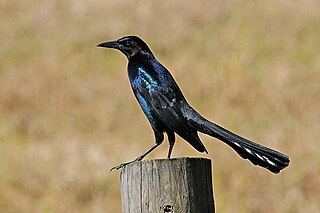
The boat-tailed grackle is a passerine bird of the family Icteridae found as a permanent resident on the coasts of the Southeastern United States.

The Carib grackle is a New World tropical blackbird, a resident breeder in the Lesser Antilles and northern South America east of the Andes, from Colombia east to Venezuela and northeastern Brazil. There are eight subspecies, of which the most widespread is the nominate subspecies of Trinidad and the South American mainland. This subspecies was introduced to Tobago in 1905 and is now common there.
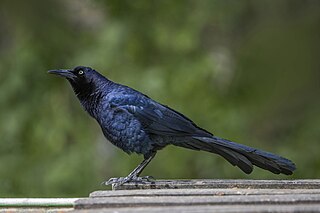
The great-tailed grackle or Mexican grackle is a medium-sized, highly social passerine bird native to North and South America. A member of the family Icteridae, it is one of 10 extant species of grackle and is closely related to the boat-tailed grackle and the extinct slender-billed grackle. In the southern and southwestern United States, the grackle is sometimes referred to simply as a "blackbird" or (erroneously) a "crow" due to its glossy black plumage; however, grackles form their own unique genus that is separate from other "blackbirds", such as the red-winged and Brewer's blackbirds, despite being in the same family (Icteridae). Superficially, Brewer's blackbird is one of the most visually similar species to grackles.

Lake Pátzcuaro is a lake in the municipality of Pátzcuaro, Michoacán, Mexico.
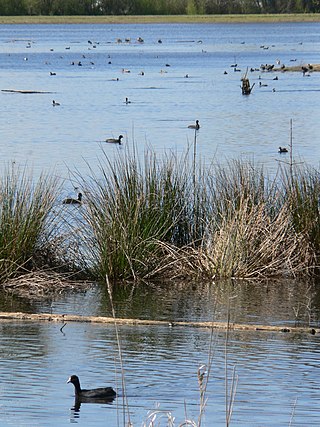
Ankeny National Wildlife Refuge is located in the fertile Willamette Valley of northwestern Oregon, 12 miles (19 km) south of Salem. The valley was once a rich mix of wildlife habitats. Valley wetlands were once extensive, with meandering stream channels and vast seasonal marshes. Today, the valley is a mix of farmland and growing cities, with few areas remaining for wildlife.

Grackles is the common name of any of 11 passerine birds native to North and South America. They belong to various genera in the icterid family. In all the species with this name, adult males have black or mostly black plumage. Baby birds like to feed by screeching.

The Nicaraguan grackle is a species of passerine bird belonging to the genus Quiscalus, a genus of grackles in the New World blackbird family, Icteridae. It is found only in Nicaragua and northernmost Costa Rica.
Palustris is a Latin word meaning "swampy" or "marshy", and may refer to:
Q. palustris may refer to:

The Central Mexican wetlands is a flooded grasslands and savannas ecoregion in central Mexico.
